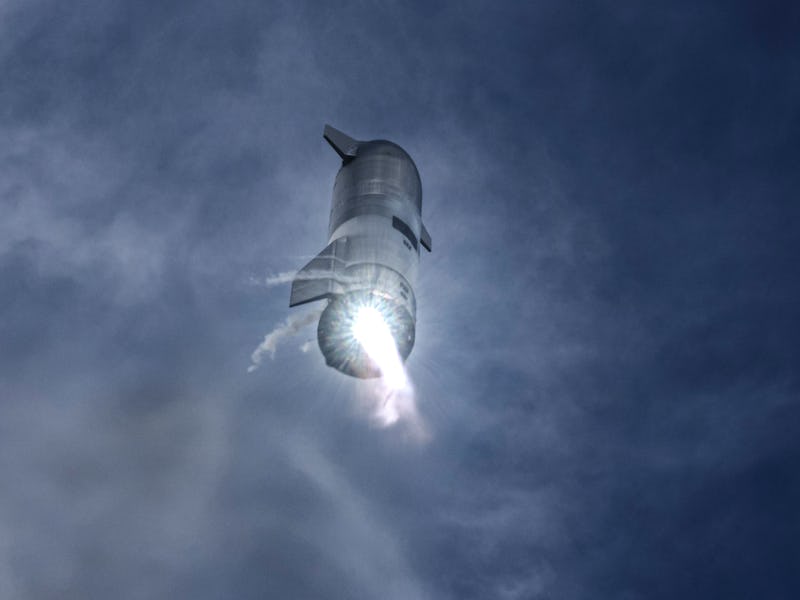SpaceX Starship: SN10 belly flops, lands, and explodes in jaw-dropping video
SpaceX's Starship SN10 event was more successful than previous attempts, but still went up in flames.

SpaceX successfully landed its Starship rocket for the first time Wednesday — only for the prototype ship to explode shortly after.
The firm hosted its third high-altitude Starship launch at its site in Cameron County, Texas, with a prototype called SN10. The goal was to lift off, reach an altitude of 10 kilometers (around 6.2 miles), then land safely. It technically met all these goals, albeit with some unexpected flames during the descent. But eight minutes after landing, the ship exploded and launched into the air, crashing down again at an angle.
"RIP SN10, honorable discharge," SpaceX CEO Elon Musk wrote on his Twitter page in the aftermath.
Want to dive deeper on where Starship is going next? Subscribe to MUSK READS+for exclusive interviews and analysis about all things Musk.
Musk also responded to live footage that showed the ship coming in to land: "SpaceX team is doing great work! One day, the true measure of success will be that Starship flights are commonplace."
SpaceX shared footage via its YouTube account of the successful launch and landing, sans the explosive ending:
Tim Dodd, who goes by the YouTube username "Everyday Astronaut," also shared footage on his Twitter page of his live reaction to the explosion eight minutes later:
The cause of the explosion is not yet known, but Ars Technica, citing informed sources, claims it may have been due to a leaking valve.
Jack Beyer, an aerospace and launch photographer, shared an image on his Twitter page Thursday that showed how the SN10 moved through its flight. The composition shows how the ship rose, belly-flopped down, and landed in a different spot from where it started.
What does SpaceX want to use the Starship for?
The launch is an important step in SpaceX's goal to send humans to Mars. The Starship is a fully-reusable ship that uses liquid oxygen and methane as its fuel. The idea is that humans can fly to Mars on the ship, create fuel using the planet's resources and techniques like the Sabatier process for return trips to Earth or ventures beyond.
Recent prototypes of the ship have three engines, while the final ship is expected to use six engines. The Starship will pair with a Super Heavy booster, packing a further 28 engines, to generate enough thrust to leave the Earth. The entire construction will measure around 400 feet tall and provide 16 million pounds of thrust.
The SN10 test performed better than its predecessors SN8 and SN9, which flew in December 2020 and February 2021 respectively. SN8 erupted in flames on the launchpad upon landing, an issue later attributed to a loss of pressure in one of the fuel tanks. Musk explained after that SpaceX would use helium to maintain pressure in the tank.
SN9 failed to adjust to the correct angle for landing and instead crashed into the ground. Musk suggested that SpaceX should have lit all three engines upon return so that it could switch off engines as desired.
SN10's flight was far more successful. It launched as expected, reached its desired altitude, and performed the expected belly flop maneuver. This, Musk explained in September 2018, would be used to slow down the ship when it enters Mars' atmosphere at speeds of up to 16,777 mph by taking advantage of aerodynamic drag, "more like a skydiver than an aircraft." It also ignited all three engines, switching down to two engines and then one for the final descent. Around six and a half minutes after launch, Starship had landed.
SpaceX has big plans for Starship. It's aiming to send Japanese billionaire Yusaku Maezawa on a trip around the Moon with eight competition winners in 2023. It's also aiming to send the first humans to Mars by the mid-2020s, as a precursor to establishing an entire city by 2050.
The Inverse analysis — This was the first time SpaceX had successfully landed a full-size Starship prototype after a high-altitude launch.
There will be questions about why the ship exploded. As mentioned, Ars Technica claimed the culprit may have been a leaking valve, citing informed sources. These valves are difficult to operate at cryogenic temperatures.
But these temperatures are necessary for the Starship's choice of fuel. EverydayAstronaut explains that oxygen's boiling point is minus 297 degrees Fahrenheit, and methane is minus 257 degrees Fahrenheit. Cooling fuels increases energy density, and as Musk explained in 2014, denser fuel means a ship has enough to burn for launching as well as landing.
Getting to Mars won't be easy.
THE STARSHIP’S JOURNEY, SUMMARIZED:
- November 2018 — BFR, first announced in September 2017, gets renamed to Starship.
- December 2018 — Musk confirms the new ship has switched to stainless steel.
- January 2019 — Shortened “Starhopper” prototype unveiled and Musk explains the switch to steel.
- February 2019 — Raptor engine beats a long-standing rocket record.
- April 2019 — Starhopper completes a tethered “hop.”
- July 2019 — Starhopper launches 20 meters (67 feet).
- August 2019 — Starhopper launches 150 meters (500 feet).
- September 2019 — Starship Mk.1 full-size prototype unveiled.
- May 2020 — Starship SN4 full-size prototype completes a static test fire.
- August 2020 — SN5 launches 150 meters (500 feet).
- October 2020 — SN8 completes the first triple-Raptor static fire.
- December 2020 — SN8 launches 12.5 kilometers (41,000 feet).
- February 2021 — SN9 launches 10 kilometers (32,800 feet).
SUBSCRIBE TO MUSK READS+, A PREMIUM NEWSLETTER THAT COVERS THE WORLDS OF ELON MUSK, SPACEX, TESLA, AND EVERYTHING BETWEEN.